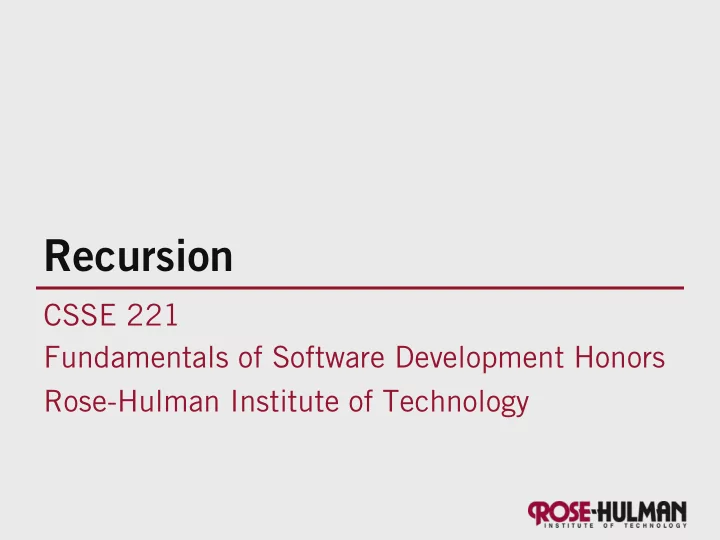

Recursion CSSE 221 Fundamentals of Software Development Honors Rose-Hulman Institute of Technology
Announcements • Exam Wednesday, Oct 23 & Friday, Oct 25 – Sample exam is posted on Moodle • We think Markov Chains are used in the SwiftKey smartphone app. – http://www.swiftkey.net/
If you don't have a base case for your recursion, it can become a nightmare!
Recursion • What is a recursive method? • A method that calls itself, but on a simpler problem • Used for any situation where parts of a whole look like mini versions of the whole: – Folders within folders on computers – Some computer languages (Scheme) – Trees in general • Cons: Takes more space (but time can be roughly equal; it depends) • Pros: Can gives code that’s very easy to understand
Recursion template • For a method that calculates a value: int foo(int n) { if (n <=1) { //Base case return (some easy expression); } else { return (some expr. with foo(n-1); //not just foo(n)) so progress } Of course, you can write void recursive methods, and ones that recurse on values other than n-1
Four Rules of Recursion 1. Base case – You need at least 1 base case that can be solved without recursing 2. Progress – You can only recurse on a simpler problem 3. “You gotta believe” – Otherwise, you’ll try to solve the problem both recursively and non-recursively. This is bad. 4. Compound interest rule – Ef fi ciency: Don’t duplicate work by solving the same instance of the problem in separate recursive calls – Later
Demo
Let’s watch in the debugger • Checkout Recursion project • Navigate to memoization package. • Let's look at stack trace for Fibonacci. fi b() • What if missing base case?
What else can we do recursively? • gcd(a,b): //assumes a > b – if a is a multiple of b, return b – Otherwise, return gcd(b, a % b) (guaranteed to be smaller) • myPow(x, a) • Program this now • Contest: Which table can write a version with the shallowest call stack?
Break
“Memoization” • What if I wish to speedup the calculation of fi b(n)? • Can I do this any faster with recursion? • What is memoization? • How can I use memoization to speedup calculation?
Mutual Recursion • Two or more methods that call each other repeatedly – For example, Hofstadter Female and Male Sequences – Burning Questions for you to fi gure out now by coding: • How often are the sequences different in the fi rst 50 positions? fi rst 500? fi rst 5,000? fi rst 5,000,000? • This is part of the homework
Two Mirrors If you actually do this, what really happens is Douglas Hofstadter appears and talks to you for eight hours about strange loops.
A graphical exercise on recursion • Sierpinski’s Triangle… – http://www.shodor.org/interactivate/activities/ SierpinskiTriangle/ • See starting code in the repository. • How can you use recursion to solve this problem? – Discuss with a partner • You may pair-program this if you want • Fun extensions: – Add color – Play with non-equilateral triangles
Recommend
More recommend